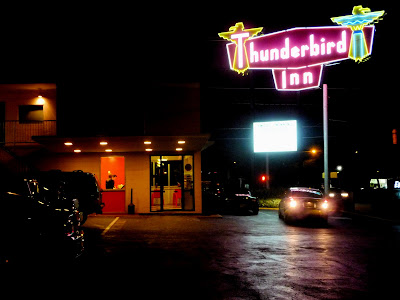







If Charleston has a pedicure and perm, Savannah wears a well-loved vintage dress, wrinkles and all. I checked into the Thunderbird Inn, a recently renovated 1960s motel. The exterior was colorful, the rooms surprisingly plush and luxurious, the staff friendly and helpful. Savannah contains an astounding twenty-four gorgeous public squares and a mix of Federal, Georgian, Gothic Revival and Italianate architecture spanning centuries. I took a self-guided walking tour of the city and daydreamed about moving there. The art school breathes life into the city—it’s just as beautiful as Charleston, but less of a museum. I ate a spectacular lunch at Cha Bella, a restaurant at the forefront of the Savannah’s farm-to-table movement. The owners of Cha Bella ripped out part of their patio to plant herbs. They own a farm a few minutes away where all of the restaurant staff, from dishwashers to servers to chefs, work cultivating and harvesting vegetables. They even have swings in the yard! I started with a cup of roasted mushroom and leek soup. With no distracting chunky texture, the thin, delicate puree captured the core of the mushrooms’ earthy flavor. Then, lo and behold! Actual fresh vegetables! A simple veggie sandwich on fresh focaccia was such a delight after all those weeks of meat eating. I would have preferred the local goat cheese that came on the salad, but the gorgonzola on the sandwich was good, and seeing some bright color on my plate for a change made me ridiculously happy.
The next night, I walked to Local Eleven Ten on the edge of historic Savannah. The space was distinctly urban, airy and loft-like with lots of black lacquer and white-painted brick. I ordered two starters, local oysters on the half shell and the house charcuterie. The oysters, served in a champagne broth with a tomato tapenade, were a bit of a disappointment. The tapenade looked and tasted like gazpacho—it drowned out the delicate briny flavor of all but the biggest oyster, which, interestingly, looked more like a jagged prehistoric rock than I’d ever seen before. The charcuterie, too, was much more appealing on the menu than on the plate—the “pickled vegetables” were jarred cornichons, and the salami, prosciutto, and bresaolo were uniformly dry and bland. I enjoyed myself anyway. The Chateau Pesquie rose was floral and delicious, the bartender capable and friendly—I suspect that, had I asked her for suggestions, my food would have been much better.
On my way out of town the next morning, I stopped at the health food store to get provisions for the Hostel in the Forest, in Brunswick, GA. A variety of local greens were on offer but I stocked up on apples and yogurt, anticipating communal dinners at the hostel.
The Hostel in the Forest is such a remarkable place that I struggle to summon words to describe it. It’s easy to see why hippies describe everything as “magical” when they live in places like this. I arrived as a guest, intending to spend three nights. I reluctantly left ten days later, having attended a staff meeting and taught a workshop, promising to return for a longer stay within the year. I could write a book about the Hostel in the Forest (perhaps I will) but I’ll aim for a degree of brevity here.
The term “hostel” seems inaccurate when describing The Hostel in the Forest. The main hub of the hostel is a geodesic dome, with nine guest tree houses spread throughout the property. Another dome is being rebuilt as a library. Though the place is partly supported by travelers, it has the feel of a utopian intentional community, with some volunteers staying for months at a time to work and live. After my three days as a paying guest, I found a niche working in the garden in the morning and cooking vegan feasts in the afternoon. I spent a day cleaning out the chicken coop. On Valentine’s Day I taught a wine-tasting workshop for guests. Work-exchangers are expected to work four to six hours a day but almost always do more because they choose their projects and the work is rewarding and fun. The hostel teaches sustainability with its composting toilets, organic garden, use of solar energy and sourcing of forest wood for building. It was such a pleasure to harvest herbs and greens, then serve them to an appreciative crowd hours later. Each night before dinner, guests and staff join hands around the fire in a circle of thanks, reciting their names, where they’re from, and a few things they’re thankful for. The hostel’s peaceful atmosphere, lush beauty and loving people made it difficult to narrow it down to a few.
Next up: sunny Florida.











